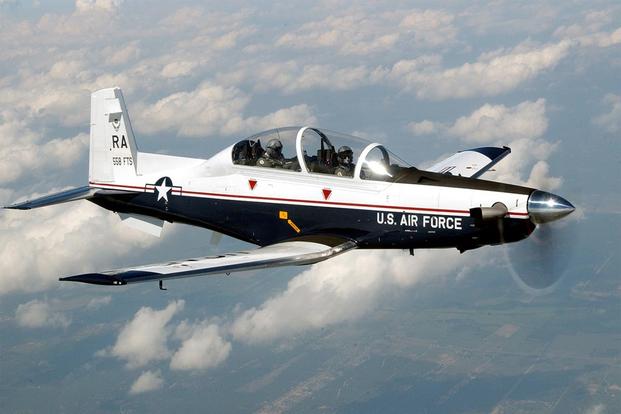The Air Force has cleared its fleet of trainer aircraft to resume training operations after a "brief pause" following the most recent crash of the T-6 Texan II, an aircraft that was grounded in February after reports of pilots suffering breathing problems.
While Tuesday's crash is under investigation, the incident will not delay the Safety Investigation Board's pending report that identifies a problem with oxygen fluctuation in the cockpit, Col. Dedra Witham, spokeswoman for Air Education and Training Command, told Military.com on Thursday.
The 12th Flying Training Wing ordered a brief pause in flight operations immediately after the crash, but it "returned to flying at noon today," Witham said.
The crash occurred just hours after Lt. Gen. Steven Kwast, commander of Air Education and Training Command, talked to reporters about the six-month SIB instigation that examined the On-Board Oxygen Generating System, or OBOGS, on the T-6.
The report outlines fixes such as adjusting the "software so that the system is delivering oxygen at a more consistent rate," he said. "It is not fully out yet ... the reality though is that we have found things we can do to help the system operate like it was designed to operate.
"When there is a fluctuation [of oxygen] that's persistent over time -- where it's at 50 percent oxygen, then it's at 70 percent, then it's at 50 percent, then it's at 80 percent, then it's at 40 percent, then it's at 100 percent," he said, "it's that fluctuation that we are finding, in the human body, on some days it does just fine with that because the normal mechanisms in your body adjust, but sometimes, and we are not sure exactly why, if you are tired, if you are dehydrated or whatever, it might be on some days a human being that dynamic can create what feels like physiological instances or hypoxia."
In February, the Air Force ordered an operational pause for the T-6 fleet after pilots suffered a series of unexplained physiological episodes, or UPEs. A team of experts determined that the OBOGS filter and drain valves failed at higher rates than expected. The discovery led to repairs and increased inspections, but pilots continued to suffer from UPEs.
"The deep work we have done ... to really find out what is the root cause of why we were having some issues with the oxygen delivery system for the T6 revealed a whole host of recommendations, and many of them are maintenance related," Kwast said, adding that the physical severity of UPEs pilots suffered " is very, very low."
"But again, our responsibility is to really know what is going on in the physics here and making sure we are doing everything in our power to make sure we have safe and effective aircraft for our aircrew to train in," he said.
-- Matthew Cox can be reached at matthew.cox@military.com.












